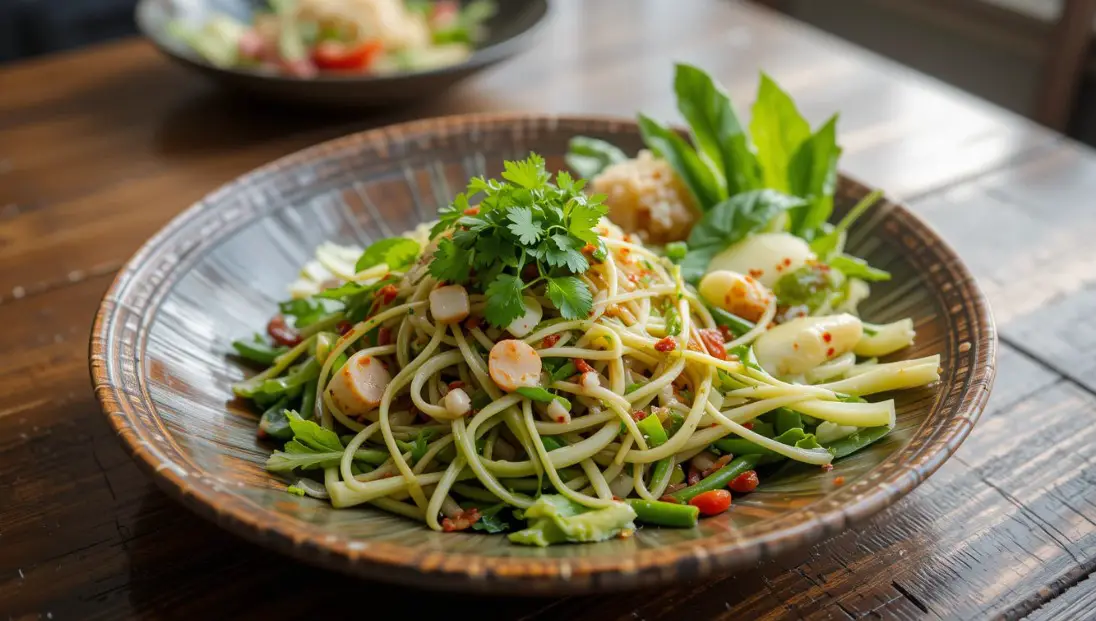Northeastern Salad originates from the Isaan region of Thailand, where bold flavors dominate the cuisine. It is a refreshing yet spicy dish made with minced pork, fresh herbs, and traditional seasonings. What makes this salad stand out is the balance of heat from the chili powder, the tanginess of lime juice, the umami depth of fish sauce, and the crunch from roasted sticky rice powder. The dish is often served with fresh vegetables such as cabbage, green beans, and Thai basil, making it a perfect blend of textures and flavors.
Essential Ingredients for a Traditional Northeastern Salad
To prepare Northeastern Salad, you’ll need fresh and authentic ingredients. Here’s a list of everything required:
Protein:
- 200g minced pork – The base of the dish, offering a tender and juicy texture.
Seasonings:
- 1 1/2 tbsp lime juice – Adds a tangy and citrusy punch.
- 1-2 tsp chili powder – Provides the essential heat.
- 1 1/2 tbsp fish sauce – Enhances the umami flavor.
- 1 tsp pork stock – Adds depth to the dish.
- 1/2 tsp sugar – Balances the flavors.
Herbs and Aromatics:
- 1 shallot, diced – Adds a mild sweetness.
- 20g coriander, chopped – Brings freshness to the salad.
- 20g long coriander, roughly torn – Boosts the herbal fragrance.
- 2 spring onions, chopped – Adds a mild onion flavor.
- 2 cloves garlic, sliced – Infuses the dish with a savory aroma.
Texture Enhancer:
- 2 tbsp sticky rice powder – Provides a nutty and crunchy element.
Cooking Liquid:
- 80 ml water – Helps cook the minced pork without drying it out.

Step-by-Step Guide: How to Make Northeastern Salad with Minced Pork
Now that we have all the Northeastern Salad ingredients, let’s prepare this delicious dish step by step.
Step 1: Preparing the Minced Pork
Start by boiling 80 ml of water in a pan over medium heat. Once the water reaches a gentle boil, add the minced pork and stir continuously. Cook for 5-7 minutes until the pork is fully cooked and slightly browned. Be sure not to overcook it, as this could make the meat dry.
Step 2: Adding the Seasonings
Once the pork is cooked, reduce the heat and immediately add the pork stock, fish sauce, lime juice, and chili powder. Stir well to ensure the flavors are evenly distributed. The key to a great Northeastern Salad is balancing these ingredients. Taste and adjust accordingly—if you prefer more heat, add extra chili powder, and if you want more tang, squeeze in more lime juice.
Step 3: Mixing in the Fresh Herbs
Turn off the heat and add the diced shallots, chopped coriander, long coriander, and spring onions. Mix everything thoroughly so that the heat from the pork slightly wilts the herbs, releasing their aroma and flavor into the dish.
Step 4: Enhancing the Texture with Sticky Rice Powder
Finally, sprinkle in the sticky rice powder and mix well. This roasted rice powder gives the Northeastern Salad its signature nutty crunch. Make sure to stir evenly so that every bite contains the perfect blend of flavors and textures.
Serving and Garnishing Tips for the Perfect Northeastern Salad
Presentation is just as important as taste when it comes to Thai cuisine. Here’s how to serve Northeastern Salad for the best experience:
- Use fresh garnishes: Top the salad with thinly sliced garlic, extra chili, and a few sprigs of coriander for added freshness.
- Pair with vegetables: Serve with crunchy green beans, lettuce, or Thai basil to complement the spicy flavors.
- Accompany with sticky rice: Northeastern Salad pairs perfectly with sticky rice, which helps balance the heat.
- Serve warm or at room temperature: Allow the flavors to meld for a few minutes before serving for a richer taste.
Why Northeastern Salad is a Must-Try Dish for Food Lovers
There are many reasons why Northeastern Salad should be on your must-try list:
- Rich in flavor: The combination of savory, spicy, tangy, and umami flavors makes every bite exciting.
- Healthy and nutritious: Packed with lean protein, fresh herbs, and aromatic spices, this salad is a healthy choice.
- Easy to make: With simple ingredients and an easy cooking process, anyone can prepare this dish at home.
- Authentic Thai experience: Making Northeastern Salad brings the taste of Thailand to your kitchen.
Final Thoughts
Now that you know everything about Northeastern Salad ingredients, it’s time to try making it at home. This dish is not only delicious but also a great way to experience the vibrant flavors of Thai cuisine. Follow this step-by-step guide, experiment with the spice levels, and enjoy a taste of Thailand wherever you are. Happy cooking!



